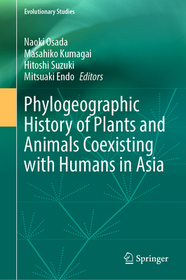
Phylogeographic History of Plants and Animals Coexisting with Humans in Asia
Series: Evolutionary Studies;
- Publisher's listprice EUR 192.59
-
79 876 Ft (76 073 Ft + 5% VAT)
The price is estimated because at the time of ordering we do not know what conversion rates will apply to HUF / product currency when the book arrives. In case HUF is weaker, the price increases slightly, in case HUF is stronger, the price goes lower slightly.
- Discount 12% (cc. 9 585 Ft off)
- Discounted price 70 291 Ft (66 944 Ft + 5% VAT)
Subcribe now and take benefit of a favourable price.
Subscribe
79 876 Ft

Availability
printed on demand
Why don't you give exact delivery time?
Delivery time is estimated on our previous experiences. We give estimations only, because we order from outside Hungary, and the delivery time mainly depends on how quickly the publisher supplies the book. Faster or slower deliveries both happen, but we do our best to supply as quickly as possible.
Product details:
- Edition number 2024
- Publisher Springer Nature Singapore
- Date of Publication 31 October 2024
- Number of Volumes 1 pieces, Book
- ISBN 9789819768868
- Binding Hardback
- No. of pages210 pages
- Size 235x155 mm
- Language English
- Illustrations VIII, 210 p. 69 illus., 54 illus. in color. Illustrations, black & white 608
Categories
Long description:
This book offers a comprehensive understanding of the natural history of the Japanese Archipelago (Yaponesia), employing cutting-edge genomic research to provide insights into the prehistory in this region. It provides an in-depth exploration of the genetic makeup of domesticated plants and animals in the Japanese Archipelago, including their relationships with neighboring regions in Asia. The book is unique in its comprehensive approach, weaving together the latest genomic research, historical records, and linguistic analysis to provide a detailed understanding of the past.
The book covers the development of Japanese society and culture from the Jomon era to the present day. It discusses the animal and plant diversity of the country, including their distribution, evolution, and interaction with human society and culture. The linguistic distributions of related terms are also explored.
Using the latest genomic research, the book offers a fresh perspective on the past and present of the Japanese Archipelago, providing a comprehensive understanding of the natural and cultural history of the Japanese Archipelago. It is a valuable resource for professionals and academics in genomics, archaeology, and linguistics, as well as general readers interested in Japanese history, culture, and the environment.
MoreTable of Contents:
Chapter 1. Overview of the book.- Chapter 2. Human impacts on the evolution of rats and mice in East Asia.- Chapter 3. Phylogeography of the brown bear (Ursus arctos) and bear-human relationships in the Far East, including Hokkaido Island, Japan.- Chapter 4. The Japanese wolf and dogs.- Chapter 5. Origin and relationships among native Japanese horse breeds.- Chapter 6. Molecular phylogeographic analyses provide a new perspective on the evolutionary origin and history of Japanese native chickens.- Chapter 7. Evaluating the interesting journey of taro plant varieties to Japan using phylogenetic analysis.- Chapter 8. History of propagation and genetic structures in three Japanese millets: proso millet, foxtail millet, and barnyard millet.- Chapter 9. Genomic studies on the origin, hybridization and dispersal of Asian rice.- Chapter 10. Wheat: Recent Advances in Genomics to Explore the History of Domestication and Polyploidization.- Chapter 11. Geographical distribution of animal and crop terms in Asian and African languages.
More







